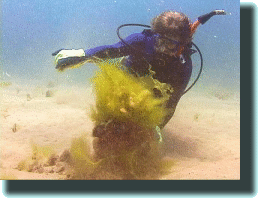
| The OK Coral, which we use as a landmark 49K JPEG |
What can we say? How can we describe the seaweed mess here? Words don't quite cut it, and photographs can't convey the severity and extent of the bloom either. The green algae slime Cladophora sericea continues to grow, both in the water and on the beach.
Portions of slime tear from the mother plant and either find anchor on a suitable substrate to grow anew, drift in the water column, or ultimately collect on the beach. Certainly the algae pile onshore is as bad as anything that happened in 1991, until now our worst algae year.
We have several favourite corals that managed to survive the 1991 bloom, and we're doing our best to remove the green slime that snags on them.

| The OK Coral, which we use as a landmark 49K JPEG |
This is one of them, the OK Coral, which we use as a landmark. When we see this feature we know that as long as we have 700 pounds of air in our tanks, we'll make it to the beach "OK."
This mixture of Cladophora, Ulva, and Hypnea, collects in great heaps on the beach 75K JPEG | 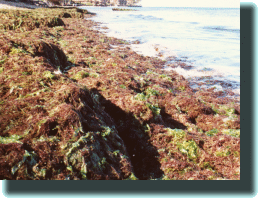
|
This mixture of Cladophora, Ulva, and Hypnea, collects in great heaps on the beach. It attracts flies, it stinks, and worst of all, it is washed back into the water at each high tide, making entry and exit into the ocean particularly nasty for us. Of course it discourages everyone but us from swimming in here.
This is the worst of three consecutive summer blooms we've had, and the volume of algae slime rivals our peak year of 1991. What's causing this? If only somebody knew...
Our biggest news this week is our sighting of a new hawksbill. We first saw this turtle resting on the reef--nothing unusual there. At first we thought it was a green sea turtle, because hawksbills usually don't rest on reefs, they rummage along them looking for tasties.
...but no, this was a hawksbill, perfectly content to rest on the reef and watch our approach.
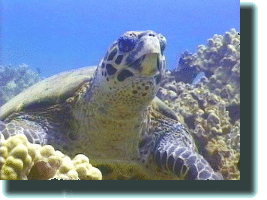
| This was a hawksbill, perfectly content to rest on the reef and watch our approach 49K JPEG |
Peter took his cue from the shell, Ursula from the face. This hawksbill wasn't Keoki! Further, it was too small to be Ake.
This cute little number was new! To our utter delight we realized we'd sighted a third hawksbill at Honokowai. It appeared rather tame, as though it might be used to divers, and it let us get close enough to get excellent left and right profiles.
We've decided to call the turtle Kiniana (Hawaiian for "Jeanne"). Dr. Jeanne Mortimer is a true champion of hawksbill conservation, and is an expert on their biology and behaviour--but her number one qualification is that she loves these animals.
So we named Kiniana after Dr. Mortimer. Kiniana is one beautiful 'ea.
Kiniana is one beautiful 'ea 52K JPEG | 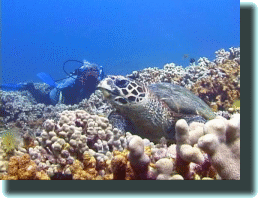
|
Of course, so are Keoki and Ake!
Speaking of beautiful, the black turtle, Ho'omalu surprised us by sticking around.
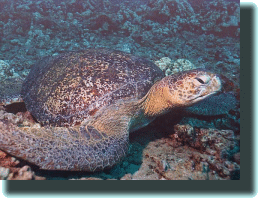
| The black turtle, Ho'omalu surprised us by sticking around 78K JPEG |
We contacted sea turtle experts and shared some photos of this turtle. We got some insights into the possible origin of Ho'omalu.
Dr. Jack Frazier suggested that she's an "East Pacific Black Turtle."
Dr. F. Alberto Abreu Grobois called Ho'omalu beautiful, and then said she was a "classic 'black turtle'." (We think she's classic too.)
All researchers who wrote urged that a skin sample be taken to determine whether Ho'omalu is a pure black turtle or perhaps a hybrid, a Hawaiian/Mexican mix.
The first to suggest this possibility was George Balazs. George believes that it's more likely that Ho'omalu is at least part honu. Underwater, we've looked very closely at her trying to find something that looks "honu"; however, our untrained eyes see only what Dr. Abreu Grobois describes as "classic black turtle" characteristics.
If she were a black on her migration route, we think she probably wouldn't be rooted to the Honokowai reef like this 52K JPEG | 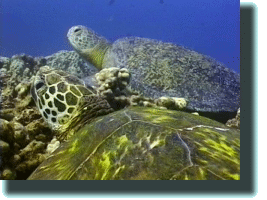
|
Still, there is an internal honu characteristic that Ho'omalu displays--she's still around. If she were a black on her migration route, we think she probably wouldn't be rooted to the Honokowai reef like this!
George will be diving with us in the next few weeks and he's determined to get a skin sample for DNA testing. Only then will we know for sure: is Ho'omalu a hybrid or is she pure? (Hey, that rhymed!)
We hope he finds her waiting for him at Mt. Balazs.
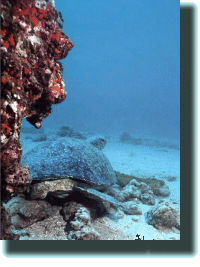
| We hope he finds her waiting for him at Mt. Balazs 46K JPEG |
We can only conclude that some turtles find humans fascinating--or at least easy marks!
This is Pumehana (Hawaiian for "warmth, affection").
This is Pumehana (Hawaiian for "warmth, affection") 52K JPEG | 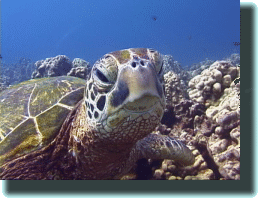
|
At the beginning of the summer she was wary of us and preferred to keep her distance. Lately, however, whenever we see her go up for air, Pumehana returns and aims directly for Ursula.
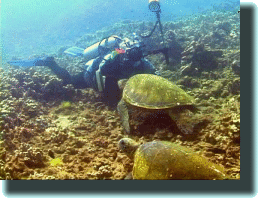
| She always picks Ursula, never Peter, swims straight at her, and lands... 61K JPEG |
Needless to say, Ursula has come to regard Pumehana with special affection. (Peter is thinking about getting jealous.)
Finally, now that we've brought up affection...
We love him. What can we say? Zeus--the name says it all--largest turtle of the bunch, resident here since at least 1992. As gentle and he is big. As gentle and big as he is beautiful. A grand male honu.
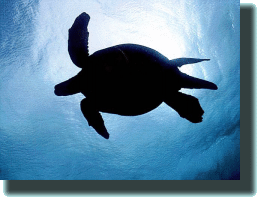
| A grand male honu 46K JPEG |
 Who's Who Underwater at Honokowai
Who's Who Underwater at Honokowai